The iPad Air Review
by Anand Lal Shimpi on October 29, 2013 9:00 PM ESTiPhone to iPad: CPU Changes
Although the iPad Air uses the same A7 from the iPhone 5s (and M7 motion coprocessor), there are a few minor differences that do lead to better performance.
At a high level we’re still talking about two 64-bit Apple Cyclone cores with 128KB L1s (64KB I$ + 64KB D$) per core, a shared 1MB L2 cache and a 4MB L3 cache that services the entire SoC. Apple increased CPU frequency from 1.3GHz to 1.4GHz in the iPad Air, a mild increase but in line with what we’ve seen from previous iPad designs. That’s the first impact on performance - a 7.69% increase in CPU frequency.
The second impact on performance is something I only noticed while digging around under the hood of the A7. It seems like the implementation in the iPad Air can, for whatever reason, hold more instructions in flight (over 20% more) than the A7 in the iPhone 5s. It’s unclear to me whether the A7 in the iPad is configured any differently via firmware/microcode or if perhaps we’re looking at a slightly different revision of the core, but the delta was repeatable in my testing.
The third, and likely biggest change impacting the iPad Air’s implementation of the A7 is the additional thermal headroom afforded by the larger chassis. I’m not going to go into details on exactly what this next test does (unfortunately we’re going to occlude some of the low level work that we do in light of all of the benchmark cheating going on), but we’re looking at a curve of performance vs. time for a particularly power heavy mix of code. We’re running the same exact code on both the iPad Air and iPhone 5s here, the only real difference is the size of the chassis:
You can see the 5s throttles back its CPU frequency to about 1GHz after the 2 minute mark. The crazy thing is that until that point the 5s manages to run at full frequency without so much as a hiccup for two full minutes, running an incredibly power hungry task. Given that most iOS apps aren’t this power intensive for such a sustained period of time, iPhone 5s users should almost always see the A7 running at a full 1.3GHz. Pretty crazy.
The iPad Air by comparison shows much more controlled behavior. Early on in the test we see a 7.7% performance advantage, which lines up perfectly with the iPad Air’s 7.7% CPU frequency advantage. By the end of the test the iPhone 5s has throttled to 900MHz, while the iPad Air drops to around 1.2GHz. At this point the iPad Air’s performance advantage grows to almost 40%.
CPU Performance
I've gone through our standard set of cross-platform browser based benchmarks to place the iPad Air's performance in perspective. As I mentioned in our 5s review, I don't know that there are many (any?) applications on iOS 7 that can really take advantage of all the A7 has to offer. There's definitely a ton of headroom left in the design. What's particularly exciting is when the A7 ends up in n-1 or n-2 iOS devices and it becomes the minimum developer target going forward.
I won't go through all of the results here again, but it's safe to say that the iPad Air is the fastest ARM based tablet on the planet at this point.
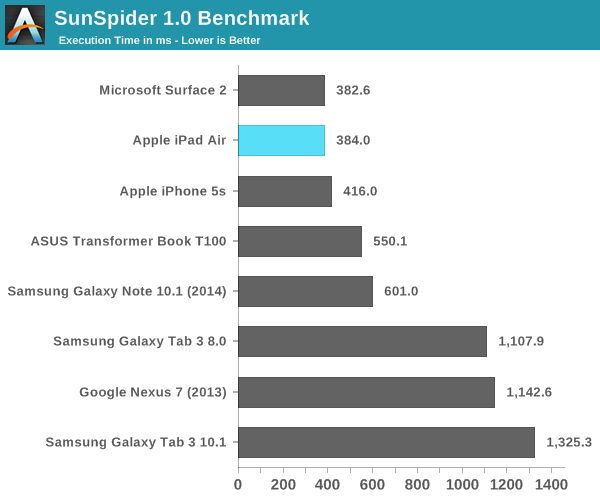
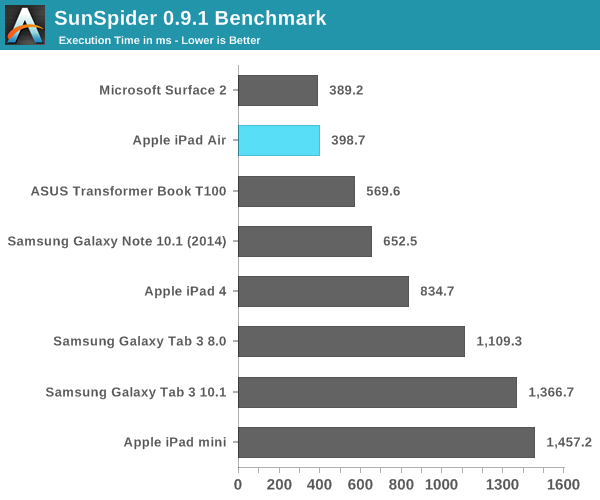
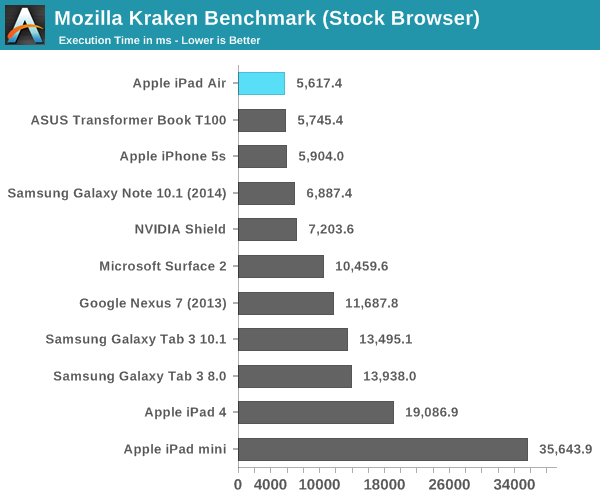
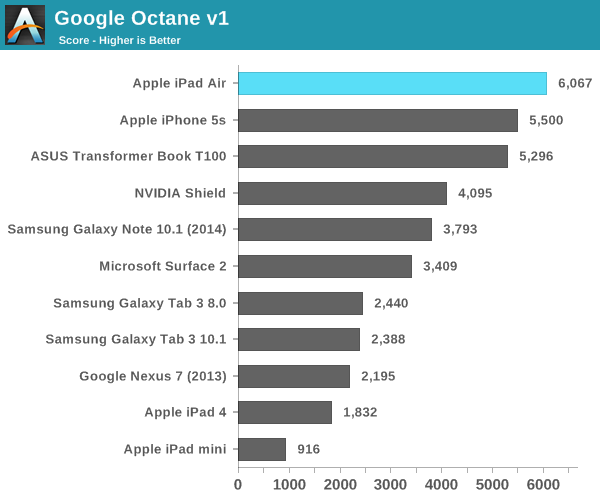
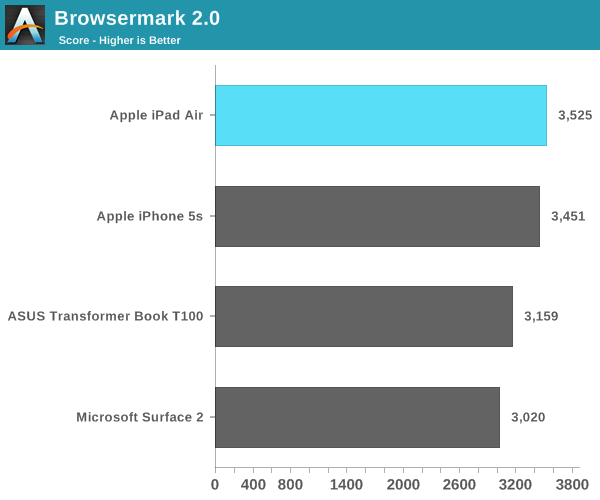

A7 Power Consumption
I’ll get to battery life in a bit, but I’ve been curious about the dynamic range of power consumption offered by Apple’s new A7 SoC. On the one hand we’re dealing with a lower power process (28nm vs. 32nm), but on the other hand Apple’s Cyclone cores can clearly draw more power given how beefy the architecture is this round. Apple frowns upon review sample dissection so I had to turn to a less scientific method of external platform level power measurement. The fidelity of the numbers here aren’t all that great but it’s better than nothing.
For the first test I measured platform power consumption during a Kraken run:
I purposely started measuring before the benchmark so I could get an idea of idle power consumption. The iPad Air consumes roughly 72% of the idle power as the iPad 4, both running at the same brightness. Here we’re not just seeing the A7’s advantages but also things like lower display power.
Focusing on the load portion of the measurement we see that both the new iPad and old iPad consume the same total power in this test. I suspect the A7 is drawing more power than the A6X, but it’s masked by a lower power display. Given how much faster the iPad Air is, Apple’s latest tablet features far lower overall task energy than the outgoing iPad 4. This is probably both the best case scenario for the iPad Air and the most likely case as well.
For kicks I wanted to see just how much power I could get the iPad Air to draw. Here I’m looking at platform power during our mini-power-virus test from above:
How’s that for dynamic range? Almost 12W running all out, but around half that in what we’d normally consider to be a stressful CPU test. I couldn’t get any actual applications/games on the iPad Air to behave like this so the results above are purely academic (for now). A quick run through GFXBench 2.7’s T-Rex HD test confirms that even pushing the GPU won’t hit these numbers. The max I saw running T-Rex offscreen was ~6W, and turning to an actual game (Infinity Blade 3) the iPad Air pulls less than 5W.


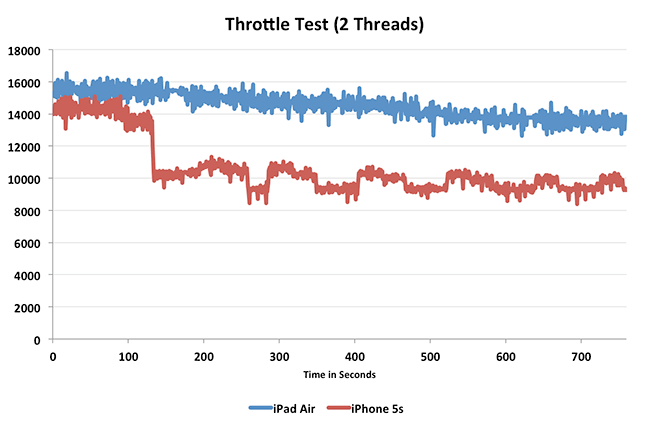
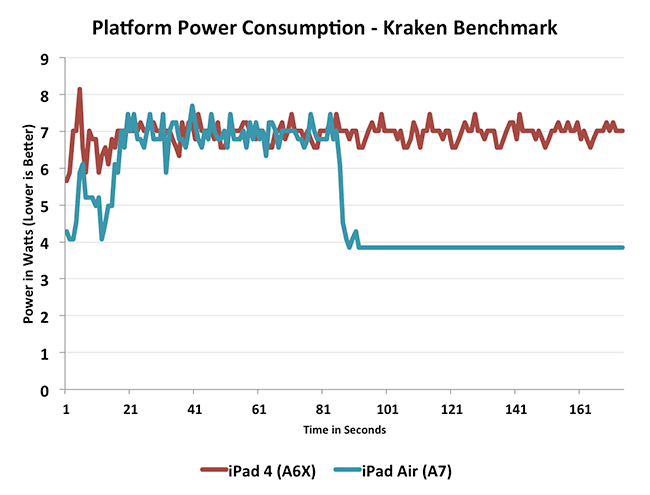
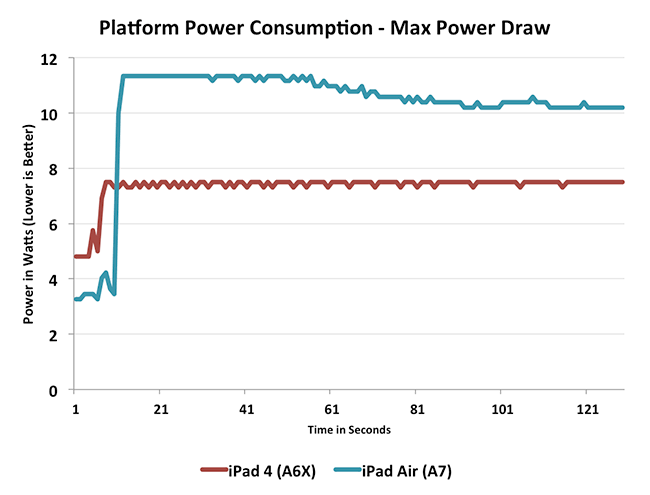








444 Comments
View All Comments
sna2 - Wednesday, October 30, 2013 - link
wrong.Most flash sticks are eMMC and they operate at 100MB/s to 200MB/s which needs usb3.
Kristian Vättö - Wednesday, October 30, 2013 - link
Read speeds can easily exceed 100MB/s because reading from NAND is much faster than writing to it. Write speeds of 32GB or smaller flash devices can barely hit 40MB/s because the NAND itself can't write faster, and it's the write speeds that matter when syncing. Even if we're dealing with a full blown SATA SSD the write performance for 32GB models is around 40MB/s. Performance does scale with capacity so a 64GB or 128GB model will be faster but we are still far away from data rates over 100MB/s.fokka - Wednesday, October 30, 2013 - link
this, so much. i'm always astounded when people bring up that they wanna see (e.g.) usb3 in their next mobile device. as if there are any current devices scratching on the 30MB-mark which would be totally possible with usb2, if manufacturers wouldn't insist on implementing bargain-bin nand and even shittier usb-controllers.FCsean - Wednesday, October 30, 2013 - link
It would be stupid of them to put thunderbolt cables for iOS devices since more than half of the owners don't own a mac. USB 3.0 would be the way to go but not everyone has USB 3.0 so they're not yet wasting their money in manufacturing USB 3.0 cables since it's a lot more expensive to manufacture. I think it's two times more expensive.darkcrayon - Wednesday, October 30, 2013 - link
Not only that, but am I the only one who rarely syncs large amounts of data at a time anymore with an iPad? Most of the sync is done wirelessly in small amounts over time. The only time I need a full many gig sync is when I upgrade devices or (extremely rarely) need to do a full wipe. Faster syncing would be nice but it's just not the daily process it used to be.Sushisamurai - Wednesday, October 30, 2013 - link
...yeah.... I don't know about u guys, but is wireless sync all the time now, either comp to iPad or iPad OTA with iCloud, wiping my device q3-6 months. I have no issues with restoring a full 32GB, and it's pretty quick... Down speeds of 10MB/s wifi, 40MB/s LTE (OTA for both), but if I were to sync via comp, a HDD to NAND is pretty abysmal speeds. Not to mention, if it was TB/USB3 u're going to have a thickness increase, and I'd rather not. Inductive charging, if u recall, is a slow, inefficient form of charging. I'd rather have my full 2A going into my iPad versuses drawing the same 12W but giving me the equivalent of 6W wirelessly. NFC and tablets? Okayyyyyyyy there.petersellers - Wednesday, October 30, 2013 - link
Doubly stupid considering that thunderbolt runs on PCI express lanes and PCI express is not present in any of these devicesekotan - Wednesday, October 30, 2013 - link
You can't have Thunderbolt without a corresponding Intel chipset, so forget about it on any ARM tablet. Also, the NAND used by these devices is so slow that having Thunderbolt would be utterly pointless. Most can't even saturate USB 2.0, never mind USB 3.0. Only the most recent Apple mobile devices have NAND fast enough to saturate USB 2.0.abazigal - Saturday, November 2, 2013 - link
I restored my 5s recently (coming from a 32gb 4s). The whole process took 1-2 minutes at most. Just plug in and click a button. Likewise, few people are so fastidious as to back up their devices via iTunes manually every day. The time savings from going thunderbolt is so minimal that unless your life somehow revolves around restoring thousands of these devices every day, I don't feel the benefits are worth the added cost.iSayuSay - Sunday, November 3, 2013 - link
And how Thunderbolt sync would help? Did you realize how much is the transfer rate from NAND flash in the iPad/iPhone? No more than 16MB/s, it's not SSD per say. It's a slow internal memory it becomes bottleneck. So as long as Apple do not change those (I doubt it will ever for the next 5 years), there's no point of porting Lightning to Thunderbolt or even USB 3.0 .. Ever.